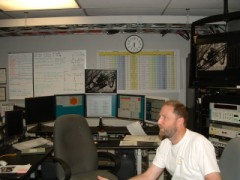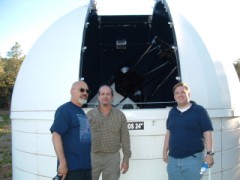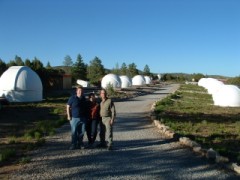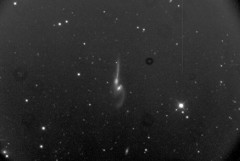Three Professors and a Telescope
 | | | Image above: from left to right; Mr. Marc Wetzel, Dr. Juan Carlos Reina, Dr. David Wood, and Mr. Alfred Alaniz standing in front of the T.O.R.R.E. telescope. |
In a recent visit to the McDonald observatory Dr. Juan Carlos Reina, astronomy professor at Houston Community College (HCC), along with Dr. David Wood and Mr. Alfred Alaniz, both astronomy professors with the Alamo Community College District (ACCD), got the chance to tour the world renowned McDonald site and look at the housing and equipment for the T.O.R.R.E. (Texas Outreach for Remote Research and Education) telescope facility. The T.O.R.R.E. site will house a refurbished 30-inch telescope that will allow observers in areas where the seeing isn’t so good to have access to top of the line equipment and resources. HCC and Rice University are cooperating on the project, and now San Antonio College with a strong Astronomy department and part of the large Alamo Community College District will join them. They aim to expand the ability of teachers and students in astronomy and space science by providing remote access for observation of the night sky, including research opportunities that would be near impossible without the level of equipment that the program will provide.
| |  | Image above: The control room of the Hobby-Eberly telescope.
|
On this particular trip to the site Mr. Marc Wetzel, the Education Coordinator for McDonald, was gracious enough to show the visiting professors the impressive array of facilities located at the world-class observatory, including the tremendous Hobby-Eberly telescope and its control room. Along with the largest telescope they were also shown the Otto Struve and the Harlen J. Smith telescope. The visiting professors not only had the opportunity to see the different scopes and their control rooms, but got to chat with some of the operators as well. The McDonald is not only home to one of the world’s largest telescopes but also hosts researchers and distinguished scientists from the world over. Located in Fort Davis TX, the observatory site has some of the darkest skies in the continental United States which gives it prime access to the secrets of the heavens. Though McDonald was not the only site visited by the professors…

| | | Image above: From left to right, Dr. Juan Carlos Reina, Professor Alfred Alaniz, and Dr. David Wood standing in front of the 24” RCOS telescope dome at New Mexico Skies. |
Nestled in the rugged Sacramento Mountains of South-Central New Mexico, sitting atop the scenic vista of Mt. Joy is the New Mexico Skies facility, a beacon to the growing sophisticated amateur astronomy community across the world. New Mexico Skies offers onsite and remote access (via internet capability) to top of the line equipment for amateur observers, hosting numerous fully capable telescope domes and a plethora of other observing facilities, the dark skies, advanced equipment and beautiful views were too much for three professors to resist.
At the gracious invitation of Mr. Lloyd Bentson III, himself a well known member of the Houston community and an experienced astro-photographer (Tejas Observatory homepage: http://lloydbentsen.com/), astronomy professors Dr. Juan Carlos Reina of Houston Community College (HCC), along with Dr. David Wood and Professor Alfred Alaniz, both from the San Antonio College (of the Alamo Community College District/ACCD) traveled to this Mecca of amateur observatories to tour the facilities and revel at the pristine night skies glowing above the impressive expanse of the New Mexico Skies facility. The three professors are eager to learn the techniques of remote observation and to look into the possibility of collaborations between their institutions (HCC and ACCD) through various grant opportunities. The relatively recent advances in technology have allowed unprecedented access to night time observations from students all around the world and the visiting professors want to try and integrate the use of such high grade equipment into the classroom, expanding the ability of students and professors that dwell in less desirable observing locations.
 | | Image above: Mr. Lloyd Bentsen standing next to his Tejas Observatory located at the New Mexico Skies Facility. Image Credit: LloydBentsen.com |
 | | | From left to right in the image above: Dr. David Wood, Geraldina Reina and Professor Alaniz standing in front of some of the telescope facilities at New Mexico Skies. |
The three professors met with the owners of New Mexico Skies, Mike and Lynne Rice to discuss the details of the services provided by the facility and to get a closer look at the array of equipment used. They were given the chance to use and experiment with one of the many telescopes in operation at the location, a 24 inch RCOS equipped with a SBIG 11000 CCD camera used for astrophotography. The result was an impressive set of images of objects including M13 (a great globular cluster in the constellation Hercules), NGC4676 (a pair of galaxies dubbed “The Mice”) and several other well known deep sky objects. So impressive was the capability of this telescope and imaging equipment that the team burned the midnight oil familiarizing themselves with it. The next day they continued to the tour of the operation with Dr. Rice and saw the 16 inch RCOS scope, owned by Mr. Lloyd Bentsen III, which also has a Takahashi 90 and an AP 130mm (both refractors) piggybacked on the 16” RCOS with a SBIG 11000 CCD camera used for imaging. They were then shown telescope housings that differed from that of the 24” and 16” RCOS scopes in that they were community telescopes which have roofs that are more constantly open that that of the others, at least on clear nights anyway. After touring the domes in the facility the visiting professors were taken to the machine shop by Dr. Rice were the milling of new parts, repairs to existing housings and the testing of new ideas for client hosting were worked out. After the extensive tour and detailed discussion of the facility the professors proceeded to converse on the advantages of collaboration in the use of such a well designed facility, they are all looking very much forward to beginning a partnership between their educational institutions and New Mexico Skies.
 | NGC 4676 is nicknamed “The Mice.” This image was captured by Dr. David Wood and Dr. Juan Carlos Reina on June 7, 2008 using a 24” RCOS telescope and SBIG 11000 CCD camera with a 15-minute exposure through a luminence filter. The unprocessed image contained pixel values ranging from 0 (dark) to 65536 (bright). The image was mildly processed by setting minimum dark pixel values to 800 and maximum bright pixel values to 3000 to stretch the contrast. Note the bright galactic cores and wispy streams of stars. There is also a fainter, more distant galaxy near the bottom center of the image. The bright stars are overexposed foreground objects.
Caption Credit: Dr. David Wood |
The trip concluded with another go at imaging on the 24” RCOS and the atmosphere more than cooperated, as the sky was much clearer than the previous night. Being more familiar with Robert Denny’s ACP control software for imaging, that was introduced the day before to the visitors by Dr. Rice, the images that were obtained surpassed those of the last attempt and more than impressed the imaging professors. All in all the excursion into the countryside of New Mexico proved more than worth while and was well regarded by all the visiting professors as a unique opportunity that served as a foray for the open possibilities of partnership.
Special thanks to Dr. Bruce Leslie, Chancellor of ACCD, Dr. Charles Cook, HCC Vice Chancellor of Instruction for their support, Dr. and Mrs. Rice for their generous hospitality and to Mr. Lloyd Bentsen for the thoughtful invitation to the New Mexico Skies facility.
|

